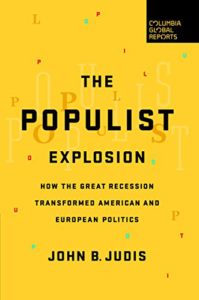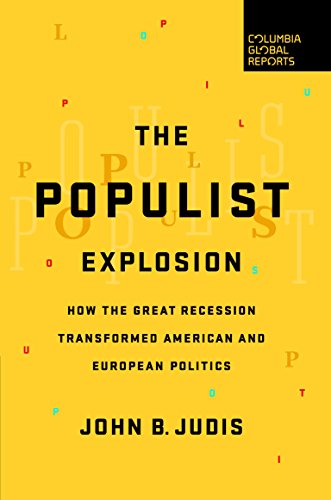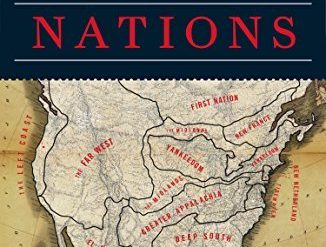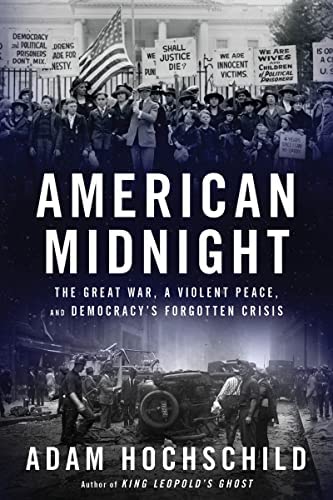
The unexpected emergence of Donald Trump as a major-party candidate for the White House has triggered a great deal of punditry about how the Republican Party managed to put forward such a bigoted and ignorant champion. Speculation has swirled around the nature of the political forces he represents. Some observers insist he, though home-grown, bears more resemblance to Benito Mussolini than to any democratic political leader. Others think of Trump’s candidacy as populist; they describe him as the embodiment of grassroots frustration with the failure of Republican leadership to deliver on its promises. Veteran journalist John Judis wades into this debate about Donald Trump and populism with a slim volume entitled The Populist Explosion: How the Great Recession Transformed American and European Politics.
Estimated reading time: 5 minutes
Rejecting facile definitions of populism
Judis’ subject is not the 2016 election but the much broader topic of the politics of protest. His argument spans more than a century, beginning with the emergence of the People’s Party in the United States late in the 19th century. Rejecting many of the facile definitions of the term, Judis insists that “there is no set of features that exclusively defines movements, parties, and people that are called populist — from the Russian Narodniks to Huey Long, and from France’s Marine Le Pen to the late congressman Jack Kemp.”
The Populist Explosion: How the Great Recession Transformed American and European Politics by John Judis ★★★★★
Describing populism on both the Left and the Right
However, the author manages to simplify the question by describing both left-wing and right-wing populism. “Leftwing populists champion the people against an elite or an establishment,” he writes. “Theirs is a vertical politics of the bottom and middle arrayed against the top. Rightwing populists champion the people against an elite that they accuse of coddling a third group, which can consist, for instance, of immigrants, Islamists, or African American militants.” Unfortunately, this distinction doesn’t much help to understand Donald Trump and the millions who back his candidacy. The views he claims on the campaign trail fit both leftwing and rightwing definitions.
Populism and the rejection of the “neoliberal consensus”
The fundamental premise in Judis’ argument is that populists on both the Right and the Left have come into prominence because of their loud opposition to what he terms the “neoliberal consensus.” He uses the term neoliberal in a fashion that encompasses Bill Clinton, the New Democrats, and (up to a point) Barack Obama as well as the uncompromising right-wing intellectuals who dominated the administration of George W. Bush. That “neoliberal consensus” includes advocacy for free trade agreements, an expansive foreign policy, low barriers to immigration, a hands-off policy toward Wall Street, and other policies that tend to widen the gap between rich and poor.
Leftwing populists such as Bernie Sanders have railed against free trade, an aggressive foreign policy, deregulation, and the failure to narrow the income and wealth gaps. Rightwing populists single out intervention in the affairs of other countries as well as free trade. Donald Trump’s often self-contradictory policies encompass both left-wing and right-wing populist positions.
Trump: not easy to pigeonhole
Judis explains: “Trump’s political base was among the party’s white working- and middle-class voters — precisely the voters who had originally flocked to [George] Wallace and then to Nixon, who had been attracted to [Ross] Perot and [Pat] Buchanan.” Caricatures aside, all these “conservative” populist leaders went against the Republican grain to oppose tax cuts for the rich and dismantling Social Security and Medicare, just as is the case with Trump. Judis also makes the point that Trump’s position on healthcare, for example, is closer to Bernie Sanders’ than it is to today’s Republican leadership’s. Yes, he wants to repeal the Affordable Care Act. But, like Sanders, sincerely or not, he advocates universal health care.
Trump as a fascist? Judis says no
Judis dismisses the contention that Donald Trump is a fascist. “Trump is a one-man show whose initial target was other Republicans,” he argues, “and who has not built a movement around himself. He has displayed anti-democratic tendencies, but they are idiosyncratic. If he has any correlate in European history, it is Italy’s Silvio Belusconi, not Mussolini nor Hitler.” However, Lawrence Rosenthal, Executive Director of the Center for Right-Wing Studies at the University of California, Berkeley, has a different view. He argues in the Huffington Post that it’s unfair to compare Trump’s campaign with the mature fascism of Mussolini. Instead, he finds a much closer correlate between Trump and the early fascist movement in Italy, which was much more difficult to pigeonhole.
Populism in both Europe and the US
Don’t be misled: The Populist Explosion is not in large part an analysis of the 2016 presidential election campaign. It’s a study of populism writ large, with examples liberally drawn from European as well as American politics over the last 130 years. If anything, Judis devotes more time to reviewing the rise of left-wing populist parties in Southern Europe (Podemos in Spain, Syriza in Greece, the Five Star Movement in Italy) and right-wing populist movements in Northern Europe (the UK Independent Party, the National Front in France, the Freedom Parties in Austria and Holland, the People’s Party in Denmark).
Though circumstances vary greatly from one country to another, Judis maintains that the Great Recession created the conditions for populist movements to gain momentum not only in the United States but throughout most of Europe as well. The widening separation between rich and poor presents a rich opportunity for the politics of protest.
About the author
John Judis began his career as a journalist nearly half a century ago. For many years, he wrote for democratic socialist periodicals, several of which he helped to found. In later years he has worked for more moderate publications such as The New Republic, The American Prospect, and, now, the digital magazine The National Journal.
For related reading
This is one of 15 books about Donald Trump and his impact on American democracy.
Like to read books about politics and current affairs? Check out Top 10 nonfiction books about politics.
If you enjoy reading nonfiction in general, you might also enjoy:
- Science explained in 10 excellent popular books
- Great biographies I’ve reviewed: my 10 favorites
- My 10 favorite books about business history
And you can always find my most popular reviews, and the most recent ones, on the Home Page.


























